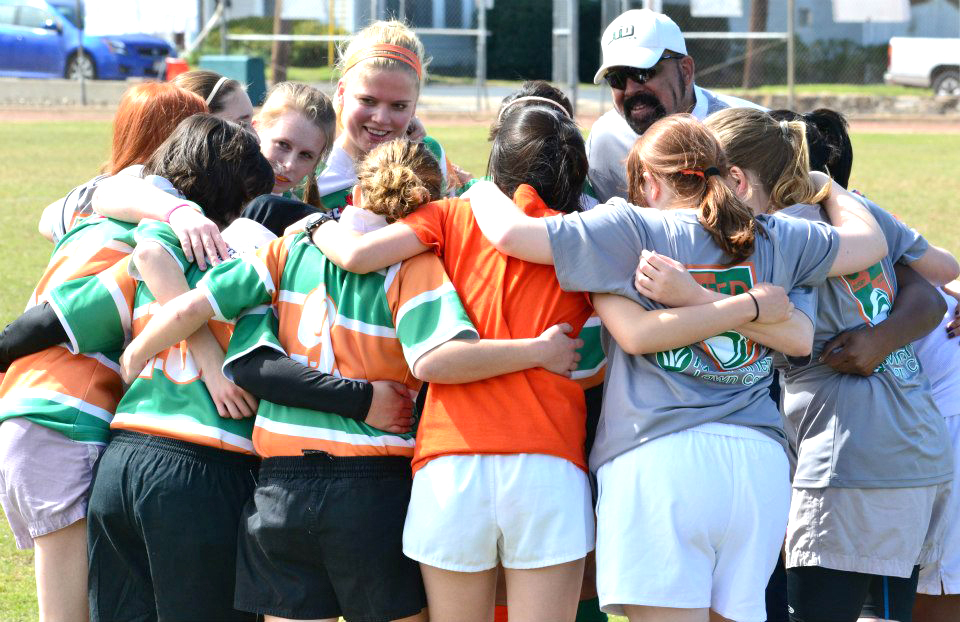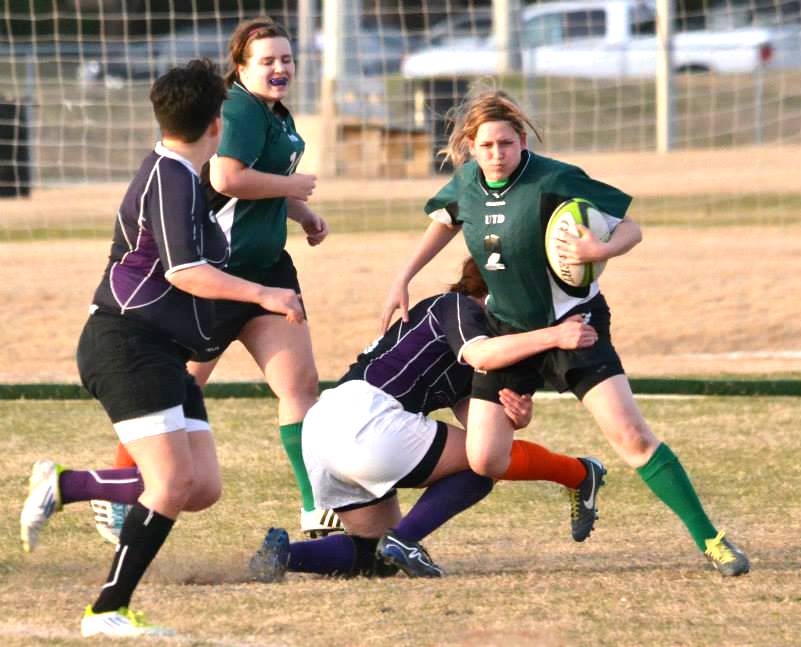
The UT Dallas women’s rugby team has grown from a handful of players in 2012 to more than 25 members.
UT Dallas sociology senior Lauren Featherstone initially tried women’s rugby after a challenge.
As managing editor of the student newspaper The Mercury, she was challenged by her staff to write a first-person article about women’s rugby because she was “one of the least athletic people” on staff they knew.
“The only thing I’d done before was yoga,” Featherstone said. “I guess they thought if I could do it, anyone could. They were surprised that I fell in love with it. I was surprised.”
Last year, Featherstone was named to the USA Rugby Collegiate Academic All-American team, a distinction given to juniors and seniors who are consistent starters on their rugby team and have grade-point averages of 3.70 or higher.
The rough-and-tumble sport has given her more stamina and self-confidence than she ever imagined. And she’s come a long way since her first practice — one bitterly cold January night on an icy field.
“Omigosh, it was so cold. There were just a handful of girls, and they had us doing burpees and bear crawls,” Featherstone said.

Last year, Lauren Featherstone (right) was named to the USA Rugby Collegiate Academic All-American team, a distinction given to juniors and seniors who are consistent starters on their teams and have least a grade-point average of 3.70.
“But I was able to keep up. I’m not the fastest player by any means, but the cool thing is, there’s a place for everyone, even if you’re not traditionally athletic. It’s extremely empowering.”
Rugby, a distinctive style of football, was developed in England in the 19th century and had a resurgence in the U.S. during the 1960s and ’70s.The United States of America Rugby Football Union — now USA Rugby — was formed in 1975.
Players use an elongated oval ball and are not allowed to throw the ball forward. They gain ground only by running with the ball or by kicking it.
It’s a fast-paced game, which makes it a fun spectator sport, too, UT Dallas coach Tony Wagner said. Teams play two 40-minute halves, and the clock only stops for injuries. Everyone gets in on the action, he said.
“Unlike football, where the quarterback and the receivers are the only ones handling the ball, all 15 players can carry the ball and score. All you need is the heart to go at it,” Wagner said.
Rugby is one of the University’s 28 club sports, which are organized and managed by students. The women’s rugby team has grown from a handful of players in 2012 to more than 25 members. UT Dallas plays in Division III of the LoneStar Collegiate Rugby Conference.
Some 10 to 15 women regularly attend practice, which is plenty to field a game. In fact, UT Dallas has one of the largest female teams in its division and often lends players to other teams that come up short, just so everyone gets a chance to play.

“I’m not the fastest player by any means, but the cool thing is, there’s a place for everyone, even if you’re not traditionally athletic. It’s extremely empowering.”
Lauren Featherstone,
who was named to the USA Rugby Collegiate Academic All-American team
Chris McAlpine, assistant director of club sports and special events, credited Wagner’s coaching for a growing interest in the sport.
“Tony has a very good philosophy on coaching. He doesn’t push them too hard, but has a lot of structure and learning, so even the newbies are quick to be successful and grow attached,” McAlpine said.
Wagner emphasizes learning by doing.
“I’m big on everyone getting a chance to play. You’ll get your bumps and bruises, but it’s all part of the game. We teach you everything you need to play the game,” he said.
McAlpine also credited team organizers for their recruitment and fundraising efforts.
It’s an easy sell because rugby builds a bond between players, said Alyssa Gelman, a speech pathology and audiology junior who started the women’s team when she was a freshman.
“Even after we play another school, both teams grab a bite to eat together and hang out. We get to know players from all across the state,” she said. “I think the camaraderie is one of the biggest reasons players keep coming out.”
That, and the game is just fun.
“We are able to teach them from square one how to do a safe and low tackle to avoid injuries,” Gelman said. “Rugby gives a chance for them to really get their hands dirty.”
Early in her rugby career, Featherstone broke her collarbone when the player she was tackling fell on top of her.
“It was the only game my parents ever went to,” she said. “I just felt winded at first. It wasn’t until I was running toward the other end of the field that I realized it really hurt, after the adrenaline wore off.”
It hasn’t slowed her down and she now wears a padded shirt during games. You just can’t allow yourself to become timid about it, Featherstone said.
“Tackling is my thing. The key is getting low and committing to it,” she said. “It’s not super common to get seriously injured. It’s not like football where you’re slamming into someone wearing plastic and metal.”
Her newfound athletic prowess motivates her to encourage other UT Dallas students to try rugby.
“If you come out three times a week for practice, you pick it up. You learn by doing. You’ll learn more your first game than any other time,” Featherstone said.